Class 10 MAHARASHTRA STATE TEXTBOOK BUREAU Solutions Maths Chapter 4 - Geometric Constructions
Geometric Constructions Exercise 4.1
Solution 1
Given,
∆ ABC ~ ∆ LMN
AB = 5.5 cm
BC = 6 cm
CA = 4.5 cm
We have to
construct ΔLMN such that ![]()
As ΔABC ~ ΔLMN,
![]()
![]() ………….
[given
………….
[given ![]() ]
]
![]() ………….
[from given values of sides]
………….
[from given values of sides]
Thus,

Now as we have all the sides, we can construct the both the triangles

Steps for construction for triangle ABC:
i) Draw a line AB of length 5.5 cm.
ii) Measure a length of 4.5 cm using a compass and draw an arc from point A.
iii) Similarly, measure a length of 6 cm using a compass and draw an arc from point B.
iv) Mark the intersection as point C.
v) Draw line CB and CA. Thus, we have the triangle ABC.
Steps for construction for triangle LMN:
i) Draw a line LM of length 4.4cm.
ii) Measure a length of 3.6cm using a compass and draw an arc from point L.
iii) Similarly, measure a length of 4.8cm using a compass and draw an arc from point N.
iv) Mark the intersection as point N.
v) Draw line MN and NL. Thus, we have the triangle LMN.
Solution 2
Given,
∆PQR ~ ∆LTR
PQ = 4.2 cm
QR = 5.4 cm
PR = 4.8 cm
We have to
construct ΔLTR such that ![]()
As ∆PQR ~ ∆LTR
![]()
![]() ………….
[given
………….
[given ![]() ]
]
Now we can construct the ΔPQRand ΔLTR

Steps for construction:
i) Construct the triangle PQR using the given values of its sides.
ii) Now, construct the line from R at an acute angle with RQ.
iii) Mark 4 equal parts on this line, and name the points R1, R2, R3, and R4.
iv) Join R3 and Q, and draw a parallel line to it from R4 meeting the extended line RQ at T.
v) Now from T draw a parallel line to PQ.
vi) Extend the line PR meeting the line from T at point L. thus, we have triangles ΔPQRand ΔLTR.
Solution 3
Given,
∆RST ~ ∆XYZ
RS = 4.5 cm
ST = 5.7 cm
∠RST = 40°
We have to
construct ΔXYZ such that ![]()
As ∆RST ~ ∆XYZ,
![]()
![]() ………….
[given
………….
[given ![]() ]
]
Thus,

Now we can construct the ΔRSTand ΔXYZ
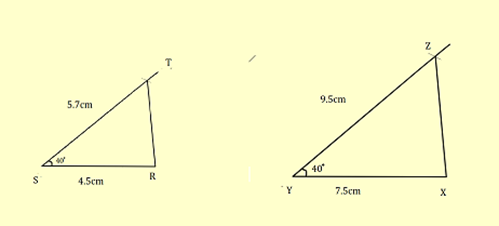
Steps for construction of triangle RST:
i) Draw line RS of 4.5cm.
ii) Using a protractor measure the angle 40°from point S, and draw a line from S.
iii) Mark point T at the distance 5.7cm on the above line. We have the triangle RST.
Steps for construction of triangle XYZ:
i)Draw line XY of 7.5cm.
ii) Using a protractor measure the angle 40°from point Y, and draw a line from Y.
iii) Mark point Z at the distance 9.5cm on the above line. We have the triangle XYZ.
Solution 4
Given,
∆AMT ~ ∆AHE
AM = 6.3 cm
AT = 5.6 cm
∠TAM = 50°
We have to
construct ΔAHE such that ![]()
As ∆AMT ~ ∆AHE,
![]()
![]() ………….
[given
………….
[given ![]() ]
]
Thus,

Now we can construct ΔAHE and ΔAMT
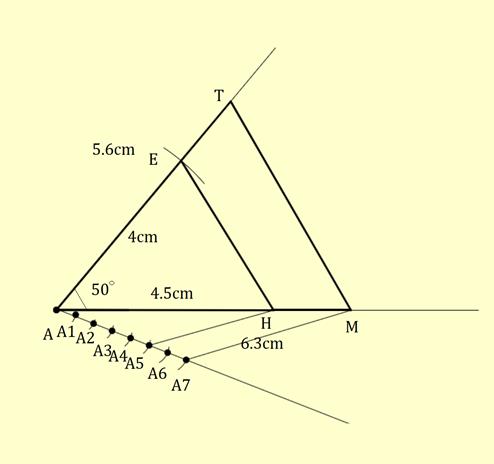
Steps for construction of ΔAHE and ΔAMT
i) Draw line AM of 6.3cm.
ii) Using a protractor measure the angle 50°from point A, and draw a line from A.
iii) Mark point T at the distance 5.6cm on the above line. We have the triangle AMT.
iv) Construct a line from A at making an angle with AM, and mark A1 to A7 equal parts on the line.
v) Join A7 and M, and draw a parallel to this line from A5.
vi) Mark this point as H.
vii) Now draw a parallel line from H, joining the line AT at E. we have triangle AHE.
Geometric Constructions Exercise 4.2
Solution 1
We have to construct a tangent to the circle with the centre P and radius 3.2 cm.
A tangent at any point on the circle is perpendicular to the line joining the point and centre of the radius.
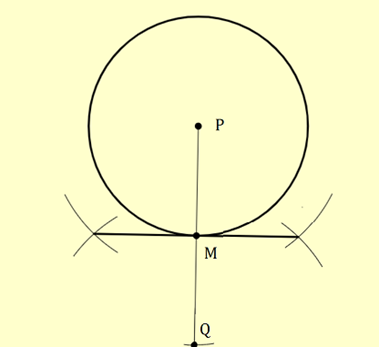
Steps for construction:
i) Draw a circle with the centre P and radius of 3.2cm.
ii) Take any point M on the circle.
iii) Construct a line that includes P and M.
iv) Mark a point Q from M on this line measuring equal to PM.
v) Use a compass with random length and mark arcs on either side of the line from the points P and Q.
v) Join the intersections of these arcs.
We have a tangent from point M.
Solution 2
We have to construct a tangent to the circle with radius 2.7 cm.
A tangent at any point on the circle is perpendicular to the line joining the point and centre of the radius.

Steps for construction:
i) Draw a circle with the centre O and radius of 2.7 cm.
ii) Take any point T on the circle.
iii) Construct a line that includes O and T.
iv) Mark a point A from T on this line measuring equal to OT.
v) Using a compass with random length and mark arcs on either side of this line, from points O and A.
v) Name the intersections of these arcs as P and Q.
vi) Join the intersections P and Q of these arcs.
We have a tangent from point T to the circle.
Solution 3
We have to draw a tangent to the circle with the radius of 3.6 cm, without using the centre.
According to the tangent secant theorem,
For the diagram below
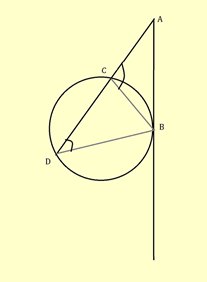
∠BDA = ∠BAC
We will construct the tangent using this theorem.
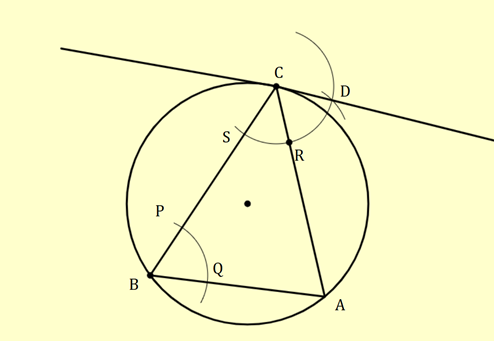
Steps for construction:
i) Draw a circle with the radius of 3.6 cm.
ii) Draw an inscribed triangle ABC.
iii) Construct an arc from point B cutting the triangle sides at points P and Q.
iv) Using the same radius draw an arc taking point C as the centre, cutting the sides at points R and S.
v) Take the measure of PQ using a compass, and using that as the radius draw an arc taking centre as R on the previous arc. Mark this point as D.
vi) Draw a line using the points C and D, we will get the tangent to the circle.
We have the tangent CD to the circle.
Solution 4
We have to draw tangents to the circle with the radius of 3.3 cm at points P and Q of the chord PQ. Length of PQ is 6.6 cm.
Also we have to give our observation about the tangents.
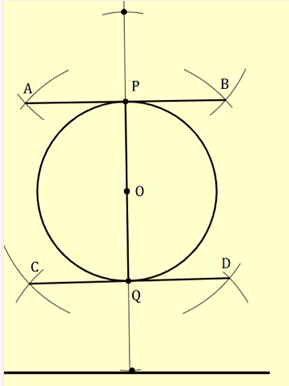
Steps for construction:
i) Draw a circle with a radius of 3.3 cm.
ii) Draw a chord PQ of length 6.6 cm. As we can see it is the diameter of the circle because it measures twice the radius of the circle.
iii) Draw perpendicular bisectors at points P and Q.
iv) These perpendicular bisectors are tangents to the circle.
We have the tangents AB and CD at points P and Q respectively.
As,
∠OPB = ∠OQD = 90°
The tangents at points P and Q are parallel.
Solution 5
We have to draw tangents to the circle with a radius of 3.4 cm at points M and N of the chord MN. Length of chord MN is 5.7cm.
According to the tangent secant theorem,
For the diagram below
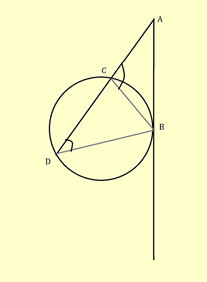
∠BDA = ∠BAC
We will construct tangents using this theorem.

Steps for construction:
i) Draw a circle with the radius of 3.4 cm.
ii) Draw a chord MN of length 5.7 cm.
iii) Take any point P on the circle and draw a triangle PMN.
iv) Taking P as the centre, draw an arc, intersecting sides PM and PN at X and Y respectively.
v) With the same radius draw circles with centres M and N.
vi) Take the length XY with the help of the compass.
vi) And mark arcs on the circles constructed in step v) taking the centres as A and B respectively.
vii) Draw the lines l and m, using the points.
We have the tangents l and m, at points M and N respectively.
Solution 6
Given the radius of the circle as 3.4 cm and the centre as P.
Q is at a distance of 5.5 cm from the centre.
We have to construct tangents from point Q to the circle.
Angle made by the diameter of the circle, with any point on the circle is 90°.
We will use this theorem to construct tangents from point Q.
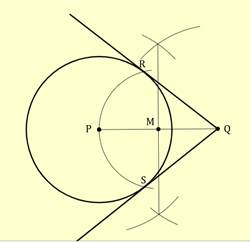
Steps for construction:
i) Draw a circle of radius 3.4 cm and the centre as P.
ii) Mark point Q at 5.5 cm from the centre P.
iii) Find the midpoint of the line PQ.
iv) Taking M as the centre and PM as the radius, draw an arc intersecting the circle with centre P.
v) Mark the point in the circle as R and S.
vi) Join QR and QS.
QR and QS are the tangents to the circle from point Q.
Solution 7
Given the radius of the circle of 4.1 cm.
Q is at a distance of 7.3 cm from the centre.
We have to construct tangents from point Q to the circle.
Angle made by the diameter of the circle, with any point on the circle is 90°.
We will use this theorem to construct tangents from point Q.
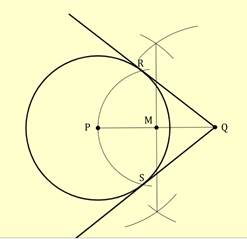
Steps for construction:
i) Draw a circle of radius 4.1 cm and the centre as P.
ii) Mark point Q at 7.3 cm from the centre P.
iii) Find the midpoint of the line PQ.
iv) Taking M as the centre and PM as the radius, draw an arc intersecting the circle with centre P.
v) Mark the point in the circle as R and S.
vi) Join QR and QS.
QR and QS are the tangents to the circle from point Q.
Geometric Constructions Exercise Problem Set 4
Solution 1(1)
The number of tangents that can be drawn to a circle at a point on the circle is 1.
Answer: Option (C) 1
For example,
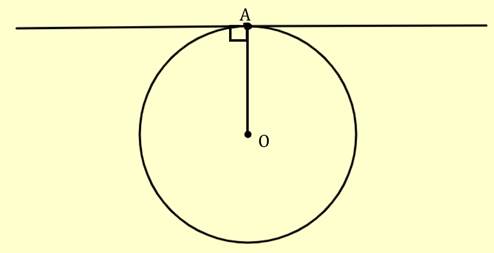
Solution 1(2)
The maximum number of tangents that can be drawn to a circle from a point outside it is 2
Answer: Option (A) 2
For example, let 'A' be the point outside the circle, we can see from A two tangents are possible on the circle, AM and AN.
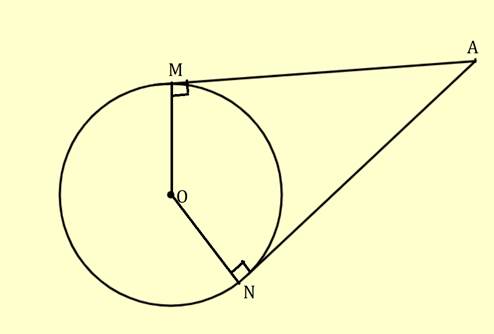
Solution 1(3)
If ∆ABC ~ ∆PQR and![]() ,
then ∆ABC is bigger.
,
then ∆ABC is bigger.
Given that,

From the statement ∆ABC ~ ∆PQR we can say,
![]()
And from the
statement![]() ,
we get,
,
we get,
![]() ………………...(1)
………………...(1)
From (1) we can say,
The measure of sides of ∆ABC is greater than the measure of sides of ∆PQR.
Therefore, ∆ABC is bigger than ∆PQR.
Answer: Option (A) ∆ABC is bigger.
Solution 2
Given;
Circle with centre O and radius 3.5 cm.
Point P is at a distance of 5.7cm from the centre.
As the tangent is perpendicular to the radius at the points of intersections of the tangents.
Angle made by the diameter of the circle, with any point on the circle is 90°.
We have to draw tangents to the circle from point P.
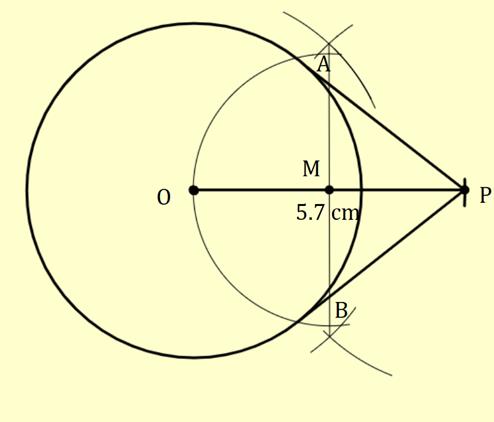
Steps for construction:
i) Draw a circle of radius 3.5 cm and mark the centre as O.
ii) Mark a point P at a distance of 5.7 cm from the centre. Join the line OP.
iii) Draw a perpendicular bisector of line OP and mark the midpoint as M.
iv) Taking the radius as OM, and the centre as M, draw an arc intersecting the circle at points A and B.
v) Join the line PA and PB.
PA and PB are the tangents to the circle from point P.
Solution 3
We have to draw a tangent to the circle from a point A on the circle, without using the centre of the circle.
According to the tangent secant theorem,
For the diagram below
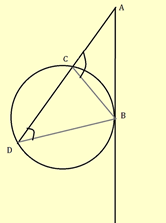
∠BDA = ∠BAC
We will use this theorem to construct the tangents.
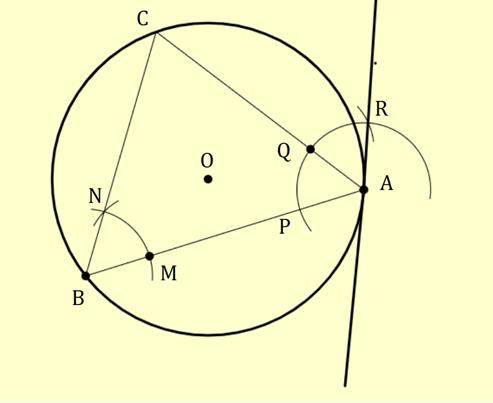
Steps for construction:
i) Draw a circle with centre O and a point A anywhere on it.
ii) Draw a triangle ABC, inscribed on the circle.
iii) Take a compass with a convenient radius and draw an arc with the centre as point B. The arc intersects at points N and M.
iv) Using the same radius, draw an arc with the centre as point A.
v) Measure the length NM with a compass, and using that as radius and centre as point Q, draw an arc intersecting the previous arc at point R.
AR is the tangent to the circle.
Solution 4
Given;
Circle with a diameter of 6.4 cm.
Point R is at a distance of 6.4 cm from the centre.
As the tangent is perpendicular to the radius at the points of intersections of the tangents.
Angle made by the diameter of the circle, with any point on the circle is 90°.
We have to draw tangents to the circle from point R.
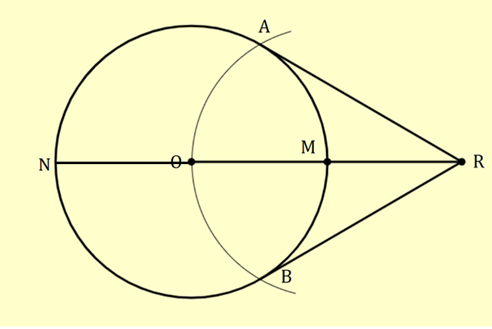
Steps for construction:
i) Draw a circle of diameter NM of length 6.4 cm and mark the centre as O.
ii) Mark a point R at a distance of 6.4 cm from the centre. Join the line OR.
iii) Mark the point on the circle and line OR as M.
iv) Taking the radius as OM, and the centre as M, draw an arc intersecting the circle at points A and B.
v) Join the line RA and RB.
RA and RB are the tangents to the circle from point R.
Solution 5
Given:
Circle with centre P
Arc AB of measure of 100°
We have to draw tangents at points A and B.
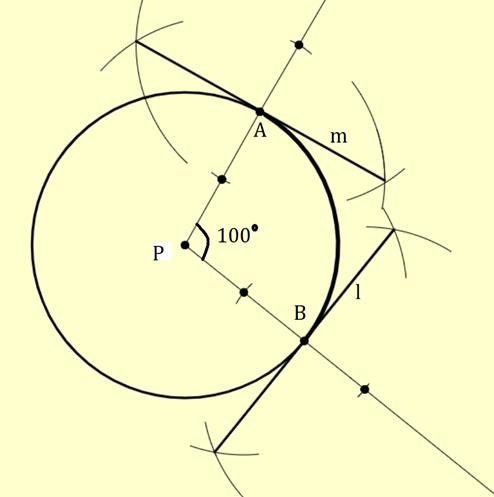
Steps for construction:
i) Draw a circle with centre P.
ii) Draw a line PA, where point A is on the circle. Measure 100°from PA and construct PB. We have the arc AB, measuring100°.
iii) Extend the line PA and PB.
iv) Construct perpendiculars to line PA and PB at points A and B respectively. Name these lines as line l and line m.
The line l and line m are tangents to the circle.
Solution 6
Given:
The radius of the circle with centre E is 3.4 cm
Point F is on the circle
Point A is such
that ![]()
And E-F-A
We have to draw tangents to the circle from point A.

Steps for construction:
i) Draw a circle of radius 3.4 cm with centre E.
ii) Mark any point of the circle as F.
iii) From F mark an arc outside the circle with a radius of 4.1 cm.
iv) Draw a line EA such that it includes point F and intersects the arc at point A.
v)As the length of EA is3.4+4.1=7.5, we mark Z as the midpoint of EA.
vi) Taking Z as the centre and radius as ZA or ZE, draw an arc intersecting the circle at two points, X and Y.
vii) Join AX and AY.
We have the tangents AX and AY to the circle.
Solution 7
Given:

We have to construct ∆ ABC and ∆LBN
As ΔABC ~ ΔLBN,
![]()

We can construct ∆ABC and ∆LBN
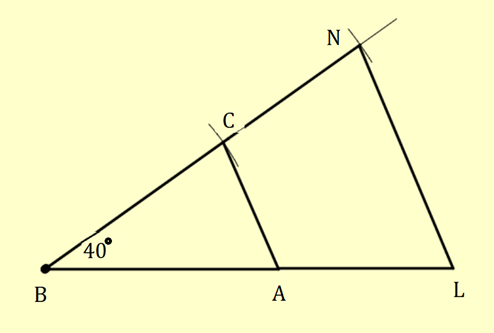
Steps for construction:
i) Draw triangle ABC, with AB= 5.1 cm, ∠B = 40°, BC = 4.8
ii) Draw triangle LBN, with LB = 8.9 cm, ∠B = 40°, BN = 8.4cm
Solution 8
Given for ∆PYQ,
![]()
![]()
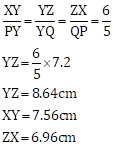
We have to construct ∆ XYZ similar to ∆ PYQ
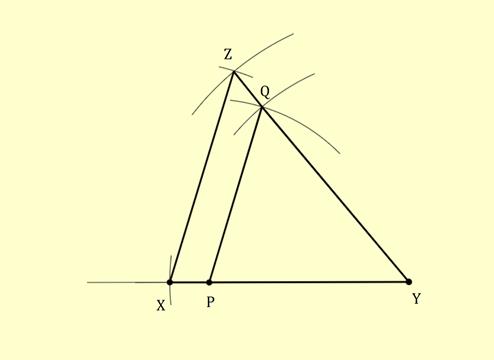
Steps for construction:
i) Draw the triangle YPQ with PY = 6.3 cm, YQ = 7.2 cm, PQ = 5.8 cm
ii) Draw the triangle XYZ with YZ = 8.64 cm, YZ = 7.56 cm, ZX = 6.96 cm

